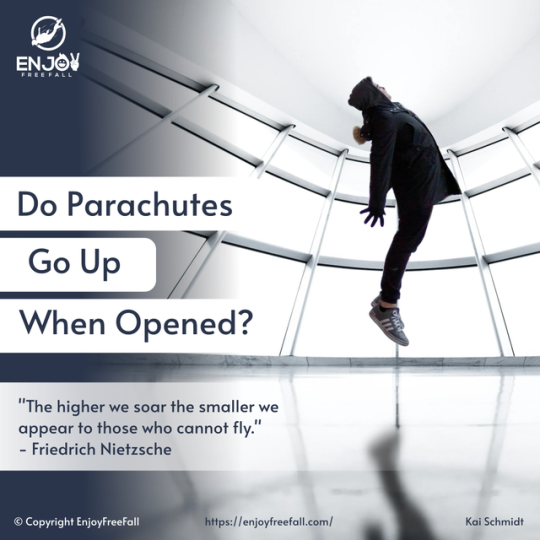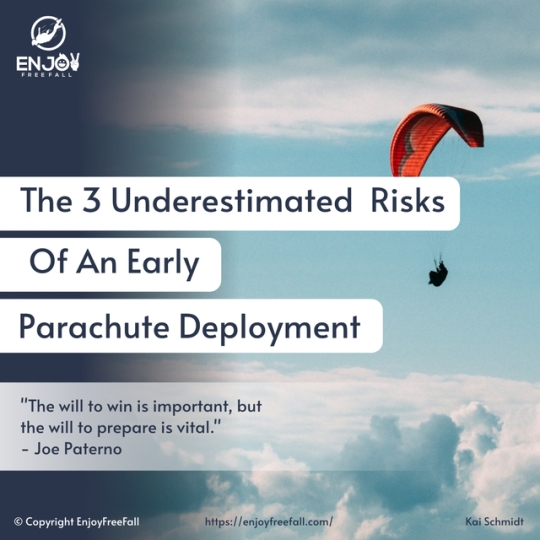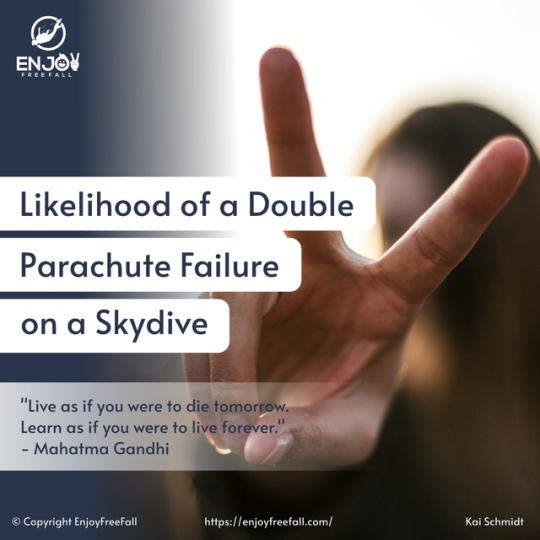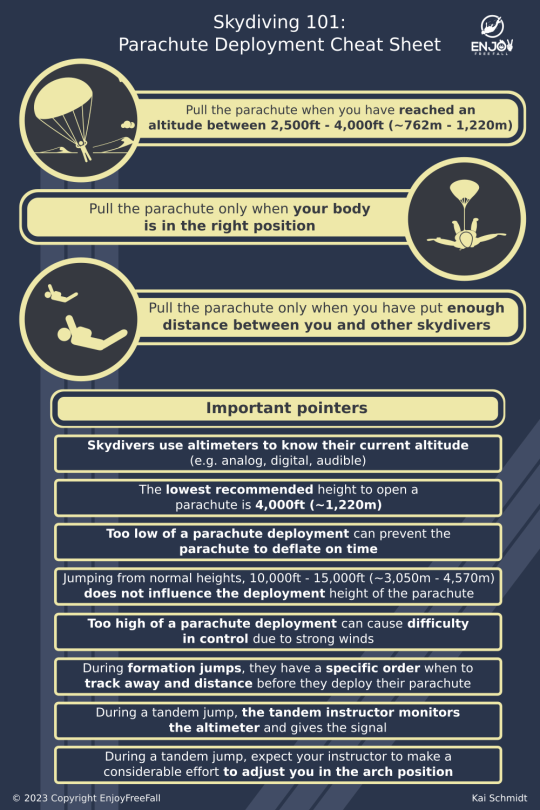#ParachuteDeployment
Explore tagged Tumblr posts
Text
The 3 Underestimated Risks Of An Early Parachute Deployment
Everyone knows that opening a parachute too low can result in extreme injuries for skydivers. However, have you ever asked yourself about the opposite? About what happens if the skydiver opens the parachute too early?
Read the article here: https://enjoyfreefall.com/the-3-underestimated-risks-of-an-early-parachute-deployment/

#Skydiving#Parachuting#SkydivingSafety#ParachuteDeployment#EarlyDeployment#SkydivingRisks#ExtremeSports#AdrenalineRush#ParachuteFacts#SkydivingTips#LearnToSkydive#SafetyFirst#ThrillSeekers#FearlessFlying#SkydivingAwareness#AdventureAwaits#EnjoyFreeFall
0 notes
Link
🪂 Skydiving is an exhilarating experience that many people dream of trying. It involves jumping out of a plane and freefalling towards the ground before deploying a parachute. But have you ever wondered how fast you fall during a skydive? 🌬️ The speed at which you fall during a skydive depends on several factors, including your body position, weight, and the altitude at which you jump. The average skydiver falls at a speed of around 120 miles per hour (193 kilometers per hour). 👨👩👧👦 Skydiving fall speed can be affected by other factors, such as the size and shape of your parachute, wind conditions, and the altitude at which you deploy your parachute. Understanding the physics behind skydiving can help you make the most of your experience and ensure a safe landing.1. Understanding the Physics of Skydiving Fall SpeedWhen skydiving, understanding the physics of fall speed is essential for a safe landing. Gravity is the force that pulls us towards the ground. Air resistance, or drag, slows us down as we fall. The heavier the person, the faster they fall. The more streamlined the body position, the faster they fall. Terminal velocity is the point where air resistance equals the force of gravity. For a skydiver, terminal velocity is around 120 mph. Jumping from higher altitudes increases the time in freefall. Air density affects fall speed, with denser air slowing down the fall. Controlling fall speed is crucial for a safe landing. Parachutes increase air resistance and slow down the fall. Deploying the parachute too early can result in a longer descent time. Deploying the parachute too late can result in a dangerous impact. Understanding the physics of fall speed is essential for a successful skydive. 🪂2. Factors that Affect Skydiving Fall SpeedSeveral factors influence the speed of a skydiver's fall. Body Position: The way a skydiver holds their body affects their fall speed. Weight: Heavier skydivers fall faster than lighter ones. Altitude: The higher the altitude, the faster the fall speed. Equipment: The type of parachute and gear used can impact fall speed. Wind Conditions: Wind speed and direction can affect a skydiver's fall speed. Body position is the most significant factor affecting fall speed. When a skydiver arches their back and extends their arms and legs, they slow down. Conversely, when a skydiver tucks their arms and legs in, they speed up. Weight and altitude also impact fall speed. Heavier skydivers fall faster due to greater gravitational pull, while higher altitudes mean less air resistance and faster fall speeds. Equipment and wind conditions can also affect fall speed. Parachutes with smaller surface areas fall faster, and strong winds can increase or decrease fall speeds. Overall, it's crucial to consider these factors to ensure a safe and enjoyable skydiving experience. 🪂3. How to Calculate Skydiving Fall SpeedWhen skydiving, it's important to know your fall speed. Here's how to calculate it: First, determine your weight in pounds. Next, subtract your weight from the weight limit of the parachute you're using. Divide that number by the surface area of your parachute in square feet. Take the square root of that number. Multiply the result by the constant 13.12. For example, if you weigh 150 pounds and are using a parachute with a weight limit of 300 pounds and a surface area of 300 square feet: 300 - 150 = 150 150 ÷ 300 = 0.5 √0.5 = 0.71 0.71 x 13.12 = 9.33 Your fall speed would be approximately 9.33 feet per second. Remember, your fall speed can be affected by factors such as your body position, altitude, and wind conditions. Always consult with a professional before attempting any skydiving maneuvers.4. Safety Measures for Managing Skydiving Fall SpeedWhen skydiving, it's crucial to manage fall speed to ensure safety. Here are some measures: Wear proper gear, including a jumpsuit and helmet. Use a drogue parachute to slow down the fall. Stay within the recommended weight limit for the parachute. Deploy the main parachute at the correct altitude. Practice proper body position to reduce air resistance. It's important to monitor your fall speed during the entire jump. Use an altimeter to track altitude and speed. If you notice that you're falling too fast, try to reduce your speed by arching your back and spreading your arms and legs. Remember to always follow the instructions given by your instructor and take safety seriously. Happy jumping! 🛩️5. Techniques for Controlling Skydiving Fall SpeedControlling your fall speed during a skydive is crucial for safety. Here are some techniques: Body Position: Arch your back and extend your arms and legs to increase surface area and slow down. Deploy Pilot Chute: Pulling the pilot chute slows you down by deploying the main parachute. Weight: Adding weights to your body can increase your fall speed or slow it down. Altitude Awareness: Knowing your altitude helps you control your fall speed and deploy your parachute at the right time. Wind Conditions: Understanding wind speed and direction can help you adjust your body position and control your fall speed. Practice these techniques with a professional skydiver before attempting them on your own. Remember to always prioritize safety!6. Advanced Strategies for Achieving Maximum Skydiving Fall SpeedWant to reach maximum fall speed while skydiving? Here are some advanced strategies: Streamline your body by keeping arms and legs close to your body Wear a skin-tight jumpsuit to reduce drag Use a smaller parachute to increase speed Another strategy is to use a "dive loop" technique, where you dive at a steep angle and then level out to gain speed. Practice proper body position and technique Consider using a wing suit for even greater speed Work with a coach or experienced skydiver for guidance and safety Remember, safety should always be your top priority. Don't attempt advanced techniques without proper training and equipment. 🪂🔥💨7. The Future of Skydiving Fall Speed TechnologyAs technology advances, so does . Here are some exciting developments: 🚀 New materials like graphene and carbon fiber will make suits lighter and more aerodynamic. 🌡️ Smart fabrics will regulate body temperature and prevent overheating during freefall. 🎮 Virtual reality training programs will improve safety and reduce the learning curve for new jumpers. Other innovations include: 🛡️ Advanced airbag systems in suits to reduce impact on landing. 🔋 Longer-lasting and more powerful batteries for electronic devices. 🤖 Drones for aerial filming and safety monitoring. With these advancements, is looking bright. We can expect to see safer, more comfortable, and more exciting jumps in the years to come. In conclusion, skydiving fall speed can reach up to 120 mph. This is due to the force of gravity pulling the skydiver towards the ground. The speed can be affected by factors such as body position and altitude. It's important to note that skydiving is a thrilling and exciting activity, but it should always be done with proper training and equipment. Safety should always be the top priority. 🛡️ So, if you're considering skydiving, make sure to do your research and find a reputable skydiving center. 🪂 https://xtremesports.net/skydiving-fall-speed/?_unique_id=649ae19845ba4
#Uncategorised#freefalltechniques#Parachutedeployment#skydivingequipment#skydivingexperience#skydivingsafetytips#aiomatic_0
0 notes
Text
How Fast Does a Parachute Open?
Skydiving is one of the unforgettable experiences in which people are carried away and lose their feeling of time and speed. After a jump, many novice skydivers wonder about the different technical details of their jump. One of the most common questions is how fast does a parachute open?
Read the article here: https://enjoyfreefall.com/how-fast-does-a-parachute-open/

#Skydiving#ParachuteOpening#SkydivingQuestions#SkydivingFacts#AdrenalineRush#ParachuteDeployment#ExtremeSports#SkydivingExperience#AerialAdventure#SkydivingSafety#FirstTimeSkydiving#ParachuteMechanics#EnjoyFreeFall
0 notes
Text
Skydiving 101: When to Pull the Parachute
Once you leave the airplane, things will happen fast: You fall for about a minute at a high speed and you have to deploy the parachute to safely reach the ground. But the most important question is when do you have to deploy the parachute?
Read the article here: https://enjoyfreefall.com/skydiving-101-when-to-pull-the-parachute/

#Skydiving101#ParachuteDeployment#SkydivingSafety#SkydivingTips#WhenToPull#SkydivingGuide#TandemSkydiving#Parachuting#SkydivingEssentials#FreefallTiming#EnjooyFreeFall
0 notes
Text
Do Parachutes Go Up When Opened?
Once skydivers have fallen to 2,500 ft, they usually deploy their parachutes and we have all watched videos where it looks like the skydiver goes up during the deployment process. But is this actually true, do parachutes go up when opened?
Read the article here: https://enjoyfreefall.com/do-parachutes-go-up-when-opened/

#SkydivingMyths#ParachuteFacts#SkydivingScience#ParachuteDeployment#ExtremeSports#SkydivingExplained#AerialAdventure#SkydivingTruths#MythBusting#SkydivingExperience#ParachuteSafety#FreefallFun#AdrenalineRush#SkydiveEducation#SkydivingJourney#EnjoyFreeFall
0 notes
Text
The 3 Underestimated Risks Of An Early Parachute Deployment
Everyone knows that opening a parachute too low can result in extreme injuries for skydivers. However, have you ever asked yourself about the opposite? About what happens if the skydiver opens the parachute too early?
Read the article here: https://enjoyfreefall.com/the-3-underestimated-risks-of-an-early-parachute-deployment/

#SkydivingSafety#ParachuteDeployment#SkydivingRisks#ExtremeSports#AdrenalineRush#ParachuteSafety#SkydivingTips#EarlyDeployment#SkydivingAccidents#SkydivingAwareness#SkydiveSmart#ParachuteFail#SafetyFirst#SkydivingAdvice#RiskManagement#EnjoyFreeFall
0 notes
Text
Likelihood of A Double Parachute Failure On A Skydive
Skydiving is quite scary for most people because you jump out of an airplane at 12,000ft and trust the parachute – basically a piece of nylon – to land safely. If the parachute and the back-up parachute do not work properly you will most certainly die. But how often do both parachutes actually fail?
Read the article here: https://enjoyfreefall.com/likelihood-of-a-double-parachute-failure-on-a-skydive/

#Skydiving#ParachuteFailure#DoubleParachuteFailure#SkydivingSafety#ExtremeSports#AdrenalineJunkie#SkydivingRisks#ParachuteBackup#ThrillSeekers#SkydivingFacts#ParachuteDeployment#SkydivingStatistics#SkydivingTips#SkydiveSafe#ParachuteSafety#EnjoyFreeFall
0 notes
Text
Minimum Altitude To Open A Parachute (And The World Records)
When I learned how to skydive, I wondered what the lowest possible altitude was to open a parachute and still land safely – because the lower I would open my parachute, the longer I could enjoy the free fall. When I researched it, I was surprised by what I found out.
Read the article here: https://enjoyfreefall.com/minimum-altitude-to-open-a-parachute-and-the-world-records/

#Skydiving#ParachuteOpening#Freefall#SkydivingRecords#ExtremeSports#AdrenalineJunkie#SkydivingSafety#MinimumAltitude#SkydivingFacts#ThrillSeekers#WorldRecords#HighAltitudeJump#SkydivingTips#SkydivingKnowledge#ParachuteDeployment#SkydiveAdventure#EnjoyFreeFall
0 notes
Text
Skydiving 101: When to Pull the Parachute
Once you leave the airplane, things will happen fast: You fall for about a minute at a high speed and you have to deploy the parachute to safely reach the ground. But the most important question is when do you have to deploy the parachute?
Read the article here: https://enjoyfreefall.com/skydiving-101-when-to-pull-the-parachute/


#Skydiving101#ParachuteDeployment#SkydivingTips#WhenToPull#SkydivingSafety#ParachuteOpening#ExtremeSports#FirstTimeSkydiver#SkydivingGuide#TandemSkydiving#AdrenalineRush#SkydivingExperience#AdventureSports#FreefallTiming#SkydivingTraining#SafetyFirst#SkydivingEssentials#EnjoyFreeFall
0 notes
Text
Do Parachutes Go Up When Opened?
Once skydivers have fallen to 2,500 ft, they usually deploy their parachutes and we have all watched videos where it looks like the skydiver goes up during the deployment process. But is this actually true, do parachutes go up when opened?
Read the article here: https://enjoyfreefall.com/do-parachutes-go-up-when-opened/

#ParachutePhysics#SkydivingMyths#ParachuteDeployment#SkydivingFacts#PhysicsOfSkydiving#SkydivingTruths#AdrenalineRush#ExtremeSports#SkydivingExperience#MythBusting#SkydivingLife#ScienceOfSkydiving#ThrillSeeker#SkydivingJourney#AdventureAwaits#EnjoyFreeFall
0 notes
Text
The 3 Underestimated Risks Of An Early Parachute Deployment
Everyone knows that opening a parachute too low can result in extreme injuries for skydivers. However, have you ever asked yourself about the opposite? About what happens if the skydiver opens the parachute too early?
Read the article here: https://enjoyfreefall.com/the-3-underestimated-risks-of-an-early-parachute-deployment/


#ParachuteDeployment#SkydivingRisks#ExtremeSports#SkydivingCommunity#AdventureSafety#AdventureAwaits#OutdoorRisk#AdrenalineRush#SkydivingFacts#OutdoorSafety#AdventureSeeker#SkydivingFAQs#ThrillSeekers#OutdoorExploration#EnjoyFreeFall
0 notes
Text
Skydiving 101: When to Pull the Parachute
Once you leave the airplane, things will happen fast: You fall for about a minute at a high speed and you have to deploy the parachute to safely reach the ground. But the most important question is when do you have to deploy the parachute?
Read the article here: https://enjoyfreefall.com/skydiving-101-when-to-pull-the-parachute/


#ParachuteDeployment#SkydivingSafety#KnowYourAltitude#WhenToPull#Skydiving101#SafetyFirst#ParachuteTiming#SkydivingInsights#AltitudeAwareness#SafeSkydiving#EnjoyFreeFall
0 notes
Text
The 3 Underestimated Risks Of An Early Parachute Deployment
Everyone knows that opening a parachute too low can result in extreme injuries for skydivers. However, have you ever asked yourself about the opposite? About what happens if the skydiver opens the parachute too early?
Read the article here: https://enjoyfreefall.com/the-3-underestimated-risks-of-an-early-parachute-deployment/


#ParachuteDeployment#SkydivingRisks#EarlyDeployment#SafetyConsiderations#SkydivingHazards#ParachuteOpening#SkydivingSafety#RiskAwareness#ParachuteTiming#SkydivingPrecautions#EnjoyFreeFall
0 notes
Text
Do Parachutes Go Up When Opened?
Once skydivers have fallen to 2,500 ft, they usually deploy their parachutes and we have all watched videos where it looks like the skydiver goes up during the deployment process. But is this actually true, do parachutes go up when opened?
Read the article here: https://enjoyfreefall.com/do-parachutes-go-up-when-opened/

#ParachuteMyths#SkydivingMyths#ParachuteDeployment#SkydivingFacts#AerialPhysics#ParachuteEffect#FreefallQuestions#GravityExplained#SkydivingScience#ChuteDeployment#EnjoyFreeFall
0 notes
Text
Skydiving 101: When to Pull the Parachute
Once you leave the airplane, things will happen fast: You fall for about a minute at a high speed and you have to deploy the parachute to safely reach the ground. But the most important question is when do you have to deploy the parachute?
Read the article here: https://enjoyfreefall.com/skydiving-101-when-to-pull-the-parachute/

#Skydiving101#ParachuteDeployment#AdrenalineRush#SkydivingSafety#WhenToPull#SafeLanding#SkydivingEssentials#JumpingIntoAdventure#ParachuteTiming#SkydivingQuestions#SafetyFirst
0 notes
Text
The 3 Underestimated Risks Of An Early Parachute Deployment
Everyone knows that opening a parachute too low can result in extreme injuries for skydivers. However, have you ever asked yourself about the opposite? About what happens if the skydiver opens the parachute too early? Read the article here: https://enjoyfreefall.com/the-3-underestimated-risks-of-an-early-parachute-deployment/

#parachute#skydiving#ParachuteDeployment#SkydivingRisks#SafetyConsiderations#EarlyOpeningDangers#SkydivingHazards#RiskAwareness#FreefallSafety#ParachuteSafety#UnderestimatedRisks#ExtremeSkydiving#SafetyFirst#AdrenalineSafety#SkydivingAwareness#JumpSafety#RiskyDeployments#FreefallDangers#SafetyAwareness#SkydivingPrecautions#ParachuteMisconceptions#RiskManagement
0 notes